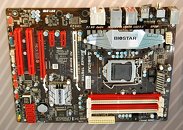- Joined
- Oct 9, 2007
- Messages
- 47,300 (7.52/day)
- Location
- Hyderabad, India
| System Name | RBMK-1000 |
|---|---|
| Processor | AMD Ryzen 7 5700G |
| Motherboard | ASUS ROG Strix B450-E Gaming |
| Cooling | DeepCool Gammax L240 V2 |
| Memory | 2x 8GB G.Skill Sniper X |
| Video Card(s) | Palit GeForce RTX 2080 SUPER GameRock |
| Storage | Western Digital Black NVMe 512GB |
| Display(s) | BenQ 1440p 60 Hz 27-inch |
| Case | Corsair Carbide 100R |
| Audio Device(s) | ASUS SupremeFX S1220A |
| Power Supply | Cooler Master MWE Gold 650W |
| Mouse | ASUS ROG Strix Impact |
| Keyboard | Gamdias Hermes E2 |
| Software | Windows 11 Pro |
Intel's upcoming Sandy Bridge processor architecture which uses the new LGA-1155 socket seems to be closer than one would think, with motherboard vendors such as Biostar being ready with motherboards that run those processors. The motherboard vendor showed off two socket LGA-1155 motherboards that are based on the Intel P67 and H67 chipsets. The P67 is engineered to be the chipset for processors that need discrete graphics, the chipset lacks the Intel FDI technology needed to connect the processors' embedded graphics controller to display outputs on the motherboard, whereas the H67 does, and is designed for processors with embedded graphics.
The first spot is the TP67XE, based on the P67. This ATX motherboard has all the features of a mid-range performance board. The processor is powered by a 4+2 phase VRM, it is wired to four DDR3 DIMM slots for dual-channel memory. It is said that the Sandy Bridge processors will have higher reference DRAM speeds than present Nehalem/Westmere chips (which have DDR3-1066 and DDR3-1333 depending on the model), expansion slots include one PCI-Express x16, one PCI-E x16 (electrical x4), two PCI-E x1, and two PCI. While the board has padding for a 2-port 3rd party USB 3.0 controller, it is indicated that Intel 6-series chipsets will finally introduce native SATA 6 Gb/s.


Next up is the TH67XE, which is based on the H67. This micro-ATX form-factor board includes all the essentials, and looks to get a value market position. A simpler CPU VRM is used, and expansion includes one each of PCI-Express x16, PCI-E x16 (electrical x4), PCI-E x1, and PCI. It features display connectivity. We are probably two quarters away from seeing any concrete signs of LGA-1155 from reaching the market.
View at TechPowerUp Main Site
The first spot is the TP67XE, based on the P67. This ATX motherboard has all the features of a mid-range performance board. The processor is powered by a 4+2 phase VRM, it is wired to four DDR3 DIMM slots for dual-channel memory. It is said that the Sandy Bridge processors will have higher reference DRAM speeds than present Nehalem/Westmere chips (which have DDR3-1066 and DDR3-1333 depending on the model), expansion slots include one PCI-Express x16, one PCI-E x16 (electrical x4), two PCI-E x1, and two PCI. While the board has padding for a 2-port 3rd party USB 3.0 controller, it is indicated that Intel 6-series chipsets will finally introduce native SATA 6 Gb/s.


Next up is the TH67XE, which is based on the H67. This micro-ATX form-factor board includes all the essentials, and looks to get a value market position. A simpler CPU VRM is used, and expansion includes one each of PCI-Express x16, PCI-E x16 (electrical x4), PCI-E x1, and PCI. It features display connectivity. We are probably two quarters away from seeing any concrete signs of LGA-1155 from reaching the market.
View at TechPowerUp Main Site




